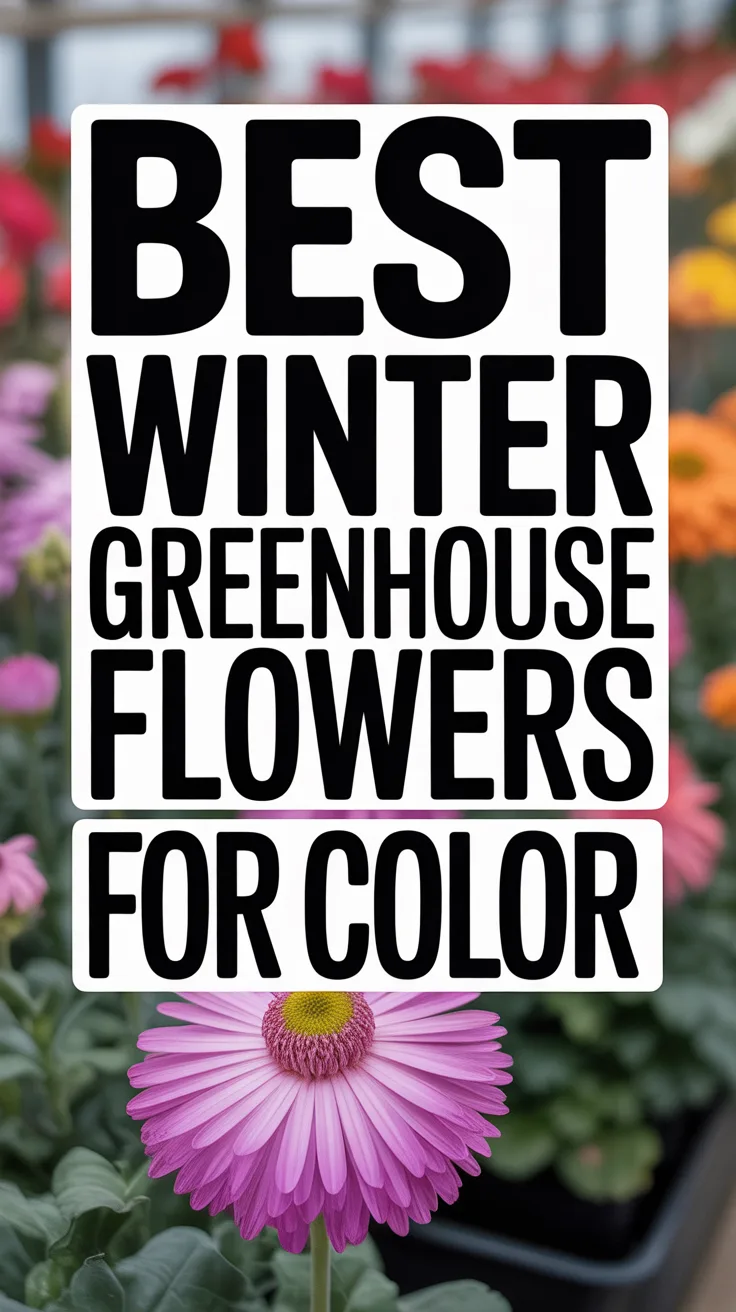Snow blankets your yard, but you crave fresh greens for a cozy winter stew. What to grow in a greenhouse in winter is the question on every gardener’s mind when frost hits. A greenhouse turns that dream into reality, delivering crisp lettuce or fragrant herbs year-round. It’s not just about food; tending plants in a warm, glowing space lifts your spirits through short, gray days.
This guide unlocks the secrets to thriving winter crops, from hardy kale to vibrant pansies. We cover the best winter greenhouse crops, care tips, and setup tricks for beginners and pros alike. Expect practical steps, like sowing schedules and budget-friendly hacks, tailored to your climate and greenhouse type. Let’s make your winter garden a green oasis. Ready to dig in?
What to Grow in a Greenhouse in Winter: Top Crop Choices
Choosing the right plants sets your winter greenhouse up for success. Focus on cold-hardy crops that thrive in cooler temps, ideally 45-60°F, which most greenhouses maintain with minimal heat. Cold-season plants for greenhouses include vegetables, herbs, and even flowers for color. Beginners, start with forgiving picks; experts, mix in fast growers for quick harvests.
Here’s a quick list to get you started:
- Leafy Greens: Spinach, lettuce, and kale tolerate low light and cool air.
- Root Crops: Carrots and radishes grow steadily in pots.
- Herbs: Parsley and cilantro add fresh flavor all season.
- Flowers: Pansies bring pops of color to dreary days.
Not all plants need a toasty greenhouse—hardy types shrug off light chills. Pick based on your setup: unheated for tough crops, heated for tender ones. This mix ensures harvests through February.
Best Winter Greenhouse Vegetables: Fresh Picks for Cold Months
Best winter greenhouse crops lean on veggies that love cooler conditions. Leafy greens and root crops top the list for ease and yield. Imagine serving homegrown salad at a snowy holiday dinner—your greenhouse makes it happen.
Leafy Greens for Steady Harvests
Spinach, kale, and Swiss chard shine in winter. Sow every two weeks for a constant supply. Keep soil at 50-60°F and water lightly to avoid soggy roots. These greens handle low light but grow faster with a simple LED grow light. Harvest outer leaves to keep plants producing.
Root Vegetables for Depth
Carrots, radishes, and beets thrive in deep pots or raised beds. Choose short-season varieties like ‘Nantes’ carrots for quicker results. Plant in loose, well-draining soil to prevent rot. Maintain 45-55°F for steady growth. Pull when roots hit 1-2 inches for tender bites.
These veggies need minimal fuss, making them beginner-friendly. Pros, try succession planting—sow small batches weekly to stretch harvests. Check out our guide to greenhouse soil prep for more tips.
Growing Herbs in a Winter Greenhouse: Flavor All Season
Herbs keep your winter meals vibrant. Winter greenhouse gardening tips often highlight parsley, cilantro, and thyme for their cold tolerance and compact growth. Picture snipping fresh parsley for a warm soup—it’s a small joy that pays off.
Plant in 6-inch pots with rich, loamy soil. Keep temps above 40°F; cilantro prefers cooler 50°F, while thyme handles 60°F. Water when the top inch of soil dries, and trim regularly to encourage bushy growth. Beginners, start with parsley—it’s forgiving. Advanced growers, propagate cuttings for endless supplies.
Eco-tip: Reuse yogurt containers as pots—just drill drainage holes. Herbs need good airflow to prevent mold, so space pots a few inches apart. This setup delivers flavor through the coldest months.
Winter Greenhouse Flowers for Color: Brighten Your Space
Flowers in winter? Absolutely. Cold-season plants for greenhouses like pansies, cyclamen, and primroses add cheer when snow piles up. They’re easier than you think and reward you with blooms for holiday decor.
Sow pansies in late fall for early winter color; they tolerate 40°F and light frost. Cyclamen prefer 50-60°F and bloom in soft pinks. Plant in well-draining soil and water sparingly—overwatering kills these beauties. Deadhead spent blooms to keep them coming. For pros, try forcing bulbs like hyacinths in chilled pots for staggered blooms.
Budget hack: Save seeds from summer annuals for next winter’s show. Your greenhouse becomes a colorful retreat, even in January’s gloom.
Managing Greenhouse Conditions in Winter: Heat, Light, and Air
A greenhouse isn’t a magic bubble—winter challenges like cold snaps and low light persist. Greenhouse winter crop care hinges on controlling temperature, light, and ventilation. Get these right, and your plants thrive.
Heating for Consistent Growth
Maintain 45-60°F for most crops; herbs like basil need 65°F. Use electric heaters with thermostats for efficiency—set to kick on at 40°F. Insulate walls with bubble wrap for unheated setups. In harsh climates, double-layer plastic sheeting traps heat. Monitor with a digital thermometer to avoid spikes.
Lighting to Boost Growth
Winter’s short days cut sunlight. Add LED grow lights (10-12 hours daily) for greens and herbs. Place 6-12 inches above plants, adjusting for intensity. Beginners, a basic 20W full-spectrum bulb works; pros, use timers for precise cycles. This mimics summer sun, speeding up harvests.
Ventilation to Prevent Mold
Open vents or fans on mild days to circulate air. High humidity invites mold, especially at 60%+. Run a small fan for airflow in tight spaces. Check plants weekly for damp spots. These steps keep your greenhouse a healthy haven.
Soil and Watering Tips for Winter Greenhouse Crops
Soil is your crops’ foundation. Winter greenhouse gardening tips stress well-draining, nutrient-rich mixes. Mix equal parts compost, peat, and perlite for most plants. Test pH—aim for 6.0-6.5 for veggies and herbs. Add slow-release fertilizer monthly to feed roots without burn.
Water sparingly; winter plants sip slowly. Check soil daily—water when the top inch feels dry. Use room-temperature water to avoid shocking roots. In humid regions, cut back to prevent rot. Eco-friendly trick: Collect rainwater in barrels for free, clean irrigation.
Troubleshooting tip: Yellow leaves signal overwatering. Drain pots and let dry out. This keeps soil happy and plants productive.
Pest and Disease Control in Winter Greenhouses: Stay Vigilant
Pests don’t sleep in winter. Aphids and whiteflies love warm greenhouses. Greenhouse winter crop care includes weekly checks for sticky leaves or tiny bugs. Spray with neem oil (1 tsp per quart water) for organic control. Keep floors clean—debris hides pests.
Mold creeps in with poor air circulation. Run fans and space plants to dry leaves. If powdery mildew appears, remove affected parts and lower humidity. Beginners, inspect under leaves; pros, introduce beneficial insects like ladybugs for natural defense. These habits stop trouble before it spreads.
Starting Spring Seeds in a Winter Greenhouse: Plan Ahead
Winter’s a prime time to kickstart spring. Sow tomatoes, peppers, and eggplants in January for early transplants. Use seed trays with heat mats set to 70°F for germination. Winter greenhouse gardening tips suggest labeling trays to track varieties. Move seedlings to bigger pots once true leaves appear.
Microgreens are a quick win—try arugula or radish for harvests in 10-14 days. Sprinkle seeds on moist soil, cover lightly, and mist daily. This bridges winter to spring, giving you a head start. Imagine potting up sturdy seedlings when snow melts.
Comparing Winter Greenhouse Crops by Difficulty
| Crop | Difficulty | Temp Range | Tips |
|---|---|---|---|
| Spinach | Easy | 45-60°F | Sow every 2 weeks, low light OK |
| Carrots | Medium | 50-60°F | Deep pots, loose soil |
| Parsley | Easy | 50-65°F | Trim often for bushy growth |
| Pansies | Easy | 40-55°F | Deadhead for more blooms |
| Tomatoes (seeds) | Hard | 65-75°F | Heat mats, early start |
This table helps you pick crops for your skill level. Beginners, stick to spinach; pros, tackle tomatoes.
FAQs About Growing Plants in a Greenhouse in Winter
What to grow in a greenhouse in winter for beginners?
Start with spinach, lettuce, and parsley. These tolerate 45-60°F and need little light. Sow in pots with drainage, water when dry, and use a basic grow light for 10 hours daily. They’re forgiving and yield fast, building confidence.
What are the best winter greenhouse crops for quick harvests?
Radishes and microgreens top the list. Radishes mature in 20-30 days at 50°F. Microgreens like arugula take 10-14 days. Sow densely in trays, keep moist, and harvest young for fresh salads.
How to grow vegetables in a greenhouse in winter without heat?
Choose kale, chard, and carrots for unheated setups. Insulate with bubble wrap and use row covers for extra warmth. Maintain 40-55°F with passive solar—face south, use dark pots. Water sparingly to avoid rot.
What are the best cold-season plants for greenhouses?
Kale, spinach, pansies, and thyme excel. They handle 40-60°F and low light. Plant in well-draining soil, vent for air, and add light for faster growth. These keep your greenhouse productive.
How do I manage greenhouse winter crop care for pests?
Check weekly for aphids or whiteflies. Spray neem oil mix (ေ
Can I grow flowers in a winter greenhouse?
Yes, pansies, cyclamen, and primroses thrive at 40-60°F. Plant in well-draining soil, water lightly, and deadhead for continuous blooms. Use small pots for easy management. They add color and joy all winter.
How do I prevent mold in my winter greenhouse?
Vent daily to lower humidity below 60%. Run a small fan for airflow. Space plants for drying. Remove any moldy leaves fast. This keeps your crops healthy.
Wrapping Up: Your Winter Greenhouse Awaits
You’re ready to conquer what to grow in a greenhouse in winter. Spinach, kale, parsley, and pansies thrive with simple care—keep temps at 45-60°F, add light, and vent for air. Water wisely, watch for pests, and start spring seeds early. These steps deliver fresh harvests and bright blooms, even in snow. Grab your pots and start today—share your winter wins in the comments or spread the word. Your greenhouse is your ticket to year-round green joy!
(Word count: 2,203)



